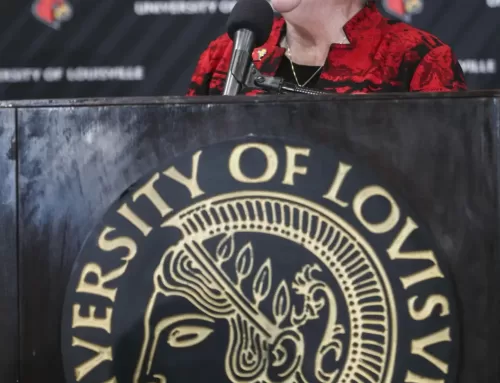If Governor Steve Beshear gets his way U of L will lose $3.5 million next year. His two-year budget cuts higher education by 2.5 percent, a loss of about $23 million for state colleges and universities.
The state legislature will modify the bill until it will be voted upon in April. “Nobody really knows what the final product will look like,” said Joseph Steffen, the chair of the faculty senate.
“I can’t really imagine that there wouldn’t be a tuition increase,” said Steffen. The university is currently researching ways to prevent this and the student group Cards in Action (CIA) is lobbying in Frankfort against the hikes.
Potentially endless cuts
The University of Louisville has been able to make tremendous strides despite incurring 14 cuts in funding in 14 years. The $3.5 million U of L will miss is miniscule compared to the overall budget of around $1 billion.
“People will feel it. It will be obvious,” said Steffen. “It keeps us from standing in place…even more, it keeps us from moving ahead.”
The new reduction in the budget has numerous predicted impacts upon students’ ability to afford college, paychecks for faculty, funding U of L hospital and keeping pace with the 21st Century Initiative.
The cuts could even deeply affect the amount of scholarship money given to students, including the Cardinal Covenant scholarship and programmatic-based scholarships. “If we can’t keep…those programs up to speed, we’re going to start losing good students too,” said Steffen.
Tuition could easily increase as a result. “Some, most, all of that will come out of student pockets,” Steffen said. “No one wants tuition to go up. Everyone will work their hardest to keep it to the minimum that will have to happen.”
Since the budget is still in its beginning stages, it is not entirely known what specific effects the budget cuts will have on the university, although much is at stake. Along with the university, students are voicing their concern of cuts directly to those responsible.
Positive propositions
Despite the negative impact on the university, there are some potentially positive parts of the proposed budget.
One of the main parts of the budget is funding for the construction of a new classroom building on the Belknap campus.
This building comes as a relief since a study revealed out of Kentucky colleges, the University of Louisville had some of the most severe space limitations on campus. This has limited the amount of space available for students to take electives at desired times.
The new building is projected to be technologically equipped and more conducive to group lectures. Although the new building is in its infancy, a prime location noted for this project has been the space between the Natural Sciences building and Grawemeyer Hall.
Another positive point in the proposed budget is access to $15 million for the University of Louisville through the Bucks for Brains program, which has been unfunded for a number of years.
Bucks for Brains started in 1997 to bring widely-known and accomplished faculty to Kentucky colleges to advance research at universities, communities and the commonealth. In order to access these funds, the university must match the state dollar-for-dollar from fundraising.
Legislative response
Since the governor revealed his budget, the state legislature has been hard at work trying to understand and amend the bill. Legislators have been meeting with university officials, students and various economic experts.
“Upset is probably too strong of a word. I think that [state legislators] are concerned,” said Dana Mayton, the senior associate vice president for governmental affairs for U of L.
“They are very much still in the information-gathering stage,” said Mayton. “They go through a very deliberative process both with public hearings and then also with their own staff doing research behind the scenes.” Some of this research includes how it will not only affect higher education , but how it will also affect students.
“I think the challenge for them is how do you re-balance. Where do you find the money to make up for cuts like ours,” Mayton said.
The state legislature is working with the University by holding one-on-one meetings with university officials and President Ramsey has visited Frankfort many times this session already.
Students take action
The University of Louisville has Kentucky’s only continuous student-lobbying program. Cards in Action was formed this year and is composed of various students who are quite vocal about the budget cuts.
“The goal of Cards in Action is to put a student perspective on rising tuition and on resource issues that we are facing,” said Carrie Mattingly, who is one of the coordinators for Cards in Action and current Student Government Association president.
Focusing on the issues of the proposed budget, Cards in Action is working on three main points when they talk with legislators: closing the 2.5 percent overall cut in education funding, advocating for the new Belknap campus classroom building and ensuring the success of the Bucks for Brains program.
Cards in Action has put testimony from students across campus at the forefront. Some students are having to become part-time at the university, take time off, work more or take out more loans to afford increasing tuition. Because classroom space is at a premium some students can’t schedule electives because there are not enough rooms at the right time.
The initiatives have been very successful. Cards In Action met legislators twice this year. Some legislators had a positive response, while others remain on the fence.
The group hopes to meet with legislators two more times before the revised budget is adopted.
University’s approach
While Cards in Action is placing the student perspective on the possible cuts, the university has been implementing ways to reduce the inevitable hit.
The most notable of these initiatives is the university’s Tax Increment Financing districts. The university’s TIFs work by having the university build an office building where renting businesses pay a tax. Part of this tax goes to the government while the other part goes directly to the university.
The most notable of these projects is the Belknap Engineering and Applied Sciences Research Park south of the J.B. Speed School and Papa John’s Cardinal Stadium.
“We’re trying to find other ways to generate money other than just tuition,” Steffen said. “These districts are going to end up paying the university over 20 or 30 year periods.”
In addition to effective fundraising, university officials are constructing and evaluating different ways to wisely decrease spending and implement more efficient business practices in order to offset the possible cuts.
Since state budget cuts began in 2001, the U of L has implemented stewardship, cost reduction and efficiency efforts that saved in the $115 million. The university has reduced spending despite the sharp cuts in state funding. Despite the proposed cuts, the university will most likely be able to continue on the same trajectory.
“We’ve looked to cut costs and save money wherever we can, but still manage to give some raises to employees. There haven’t been any widespread layoffs,” said Mark Hebert, the director of media relations for the university. “We haven’t had to cut a lot of services, we haven’t had to cut student programming.”
The potential result
Since the final version of the budget will not be up for a vote until April, it is too early to gauge how these proposed cuts will affect specific functions and students. “It’s really early in the process. We’re not going to know what we’re getting or not getting until the middle of April,” says Hebert.
Regardless of the processes at work, the proposed budget includes many high and low points for the U of L. Bucks for Brains and the new classroom building are in limbo as the state legislature debates and revises the budget.
One thing is for certain says Hebert. “There’s no question that there are going to continue to be tuition increases for students. The question is how much are they going to have to be to offset the cuts that we’ve got and to keep the academic standing and the academic standards that we’ve met…and to keep us moving forward.”
“We’re on the ground everyday, fighting the good fight,” said Mayton.



